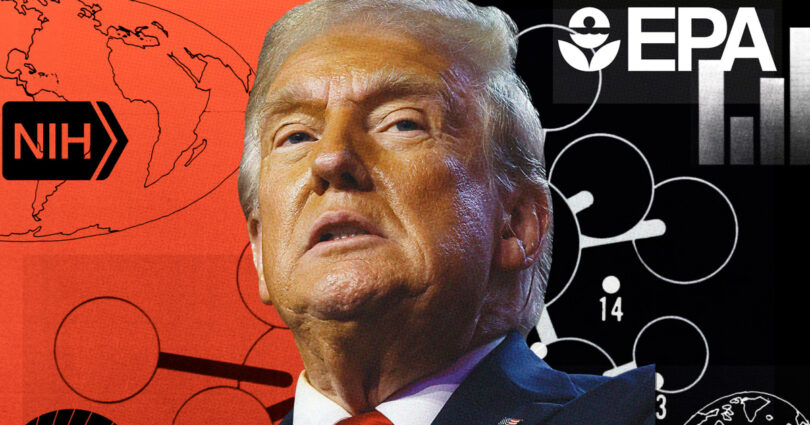“This is simply the end.”
That was the five-word message that Rick Huganir, a neuroscientist at Johns Hopkins University in Baltimore, received from a colleague just before 6 p.m. two Fridays ago, with news that would send a wave of panic through the scientific community.
When Huganir clicked on the link in the email, from fellow JHU neuroscientist Alex Kolodkin, he saw a new National Institutes of Health policy designed to slash federal spending on the indirect costs that keep universities and research institutes operating, including for new equipment, maintenance, utilities and support staff.
“Am I reading this right 15%??” Huganir wrote back in disbelief, suddenly worried the cut could stall 25 years of work.
In 1998, Huganir discovered a gene called SYNGAP1. About 1% of all children with intellectual disabilities have a mutation of the gene. He’s working to develop drugs to treat these children, who often have learning differences, seizures and sleep problems. He said his research is almost entirely reliant on NIH grants.
The search for a cure for these rare disorders is a race against time, because researchers think treatment will be most effective if administered when patients are children.
“We’re developing therapeutics for the kids and may have a therapeutic that could be curing these kids in the next several years, but that research is going to be compromised,” Huganir said in an interview, estimating that scientists in his field could start a Phase 1 clinical trial within the next five years. “Any delay or anything that inhibits our research is devastating to the parents.”
From cancer researchers to those working in maternal health, Huganir’s predicament is familiar to many scientists across the country right now. Less than a month into his administration, President Donald Trump has embarked on a cost cutting program that threatens to reshape the infrastructure that has made the U.S. the envy of the world in medical innovation. His administration has frozen federal grants, ordered sweeping layoffs across federal agencies, cut funding for biomedical research and issued executive orders that threaten to shutter government programs focused on gender or diversity.
The NIH policy is only one piece of a dramatic overhaul of the federal agencies that has included aggressive and at-times untargeted cuts to scientific research. A judge halted the National Institutes of Health policy a little more than a week ago, at least temporarily, after 22 state attorneys general filed a lawsuit. Still, it has left some scientists, like Huganir, in fear they may have to slow or abandon research projects, potentially walking back years of progress and preventing new scientific breakthroughs. NIH did not respond to a request for comment after a request from NBC News on Friday.
The new administration’s blitz has provoked outcry among researchers, doctors and university leaders, many of whom are organizing for a showdown — in the courts and in public opinion — to save institutions, money and workers who have propelled research for decades.
“There’s a battle ahead to protect not just the funding, but the social contract that the federal government and institutions have had to enable the scientific research enterprise in America in the last 80 years,” said Holden Thorp, the editor-in-chief of the Science family of scientific journals.
In an emailed statement, White House spokesperson Kush Desai said the Trump administration was focused on better using taxpayer dollars on research, trimming the nation’s “bloated bureaucracy” and streamlining government operations.
“The Trump administration is committed to slashing waste, fraud, and abuse while increasing transparency of where limited taxpayer dollars from NIH are going and how exactly they’re advancing scientific research and development,” Desai said. “Contrary to the hysteria, redirecting billions of allocated NIH spending away from opaque administrative expenses means there will be more money and resources available for legitimate scientific research, not less.”
We’re looking to hear from federal government workers. If you have more information on DOGE at your agency, please email us at tips@nbcuni.com or contact us through one of these methods.
Cuts to employees, funding and research
The flurry of activity in recent weeks stems from Trump’s executive orders that aim to shrink the federal workforce and target programs related to gender identity, environmental justice or diversity, equity and inclusion.
In upending the scientific status quo, the Trump administration has focused on three main areas: cutting federal workers, slashing budgets and reversing efforts to expand diversity within science.
Its most significant financial move took place on Feb. 7, when NIH announced it would limit indirect funding for laboratories that receive federal research grants to 15%. The policy, if allowed to continue, would slash billions of dollars for overhead costs that support biomedical research.
Though NIH estimated that the move would save $4 billion each year, it would also leave universities and research institutes to foot much of the bill instead, and many have said they simply can’t.
Today, when a scientist at Johns Hopkins University receives an NIH grant for a project — say, $1 million a year — the university receives an additional 55%, or $550,000, to cover overhead costs. The rate is negotiated between NIH and Johns Hopkins, and it’s based on an accounting of the university’s research expenses.
“This is a huge cut. Johns Hopkins Medical School would lose $200 million a year,” Huganir said. “It’s not a viable enterprise to do science.”
In a written statement supporting the lawsuit from the 22 attorneys general, Michigan State University said a reduction in funding could force the university to abandon construction of a $330 million research building designed to support the study of cancer, cardiovascular disease and neuroscience.
It could also cut funding for the university’s MIRACLE Center, which pilots initiatives to reduce maternal and infant death, such as home medical visits or a support app for expectant mothers.
“Without the indirect cost recovery, we would have to close it down or lay off many people,” Douglas Gage, the university’s vice president for research and innovation, said of the center.
In a separate lawsuit, the Association of American Universities argued that smaller institutions “will not be able to sustain any research at all and could close entirely.”
The uncertainty is affecting prospective students as well.
William Tate IV, the president of Louisiana State University, said the university had to change language in acceptance letters for graduate students on Thursday.
“Historically, we say, ‘Welcome to LSU. You have a graduate assistantship. We’ll see you in August,’” Tate said. “Now, we have to have the caveat: ‘assuming we’re funded.’”
While many scientists aren’t opposed to reducing costs within federal agencies, they have taken issue with the way the Trump administration has broadly gutted budgets and staff without considering the ripple effects within the agencies.
“I like the ambition of trying to identify government waste and trying to reduce regulations that are outdated or inefficient,” said Stuart Buck, executive director of the Good Science Project, a nonprofit that aims to improve the funding and practice of science.
“But I would worry that when the first thing out of the gate is to slash costs and slash employees, I think you end up possibly in the worst of all worlds, because now you have just as many bureaucratic hoops and regulations to jump through and not as much money or not as many people to handle it,” said Buck, who has critiqued NIH’s funding structure in the past.
Even a brief pause in a research project due to a freeze in federal funding or uncertainty about whether a project violates the president’s executive orders could cause damage.
“The uncertainty creates huge disruptions,” said Arati Prabhakar, former director of the White House Office of Science and Technology Policy under the Biden administration. “If it’s research that involves clinical trials with patients with diseases that they are desperately hoping to have treated, that’s just unethical to stop clinical trials and not be able to complete that kind of work.”
We might lose the lead on an entire field of research.
Deborah Stine, founder of the Science and Technology Policy Academy
Major reductions in scientific funding will likely have ripple effects for generations to come, according to David Stensrud, a professor of meteorology and atmospheric science at Pennsylvania State University and president of the American Meteorological Society.
“The science investments that the government makes are just a few percent of the overall budget, but they are incredibly important investments in the next generation of scientists and the next generation of ideas,” Stensrud said.
Halting or abandoning research projects could also lead the U.S. to fall behind other countries in terms of scientific advancement, and encourage talent and investments to flow elsewhere.
“If we don’t keep up, then, believe me, there’s plenty of work happening in Europe and in China,” said Deborah Stine, founder of the Science and Technology Policy Academy, an education services company. “We might lose the lead on an entire field of research.”
Huganir, for instance, said he’s trying to recruit 10 new faculty members in neuroscience and he thinks the odds of bringing in strong candidates from England and Germany have decreased because of the uncertainty around funding.
Dr. Joshua Barocas, an associate professor at the University of Colorado School of Medicine, said meetings of the scientific council that reviews grants and makes determinations for funding are still on pause.
“The entire cycle is disrupted. And when we disrupt the cycle for even a week, a month, that’s thousands of scientists, thousands of experiments and thousands of nonfederal employees who are impacted,” Barocas said at a media briefing hosted by the Infectious Diseases Society of America.
In a news release on Friday, Sen. Tammy Baldwin, D-Wis., said the Trump administration had halted all grant funding for 10 days, which meant that research institutions had received about 3,600 fewer NIH grants and $1 billion less in total funding in comparison to previous years.
Fewer workers, a more burdensome workload
As the administration seeks radical changes to research funding, it has also sought to cut employees at federal scientific agencies.
Wide-ranging cuts of probationary workers — who are typically in their first year of employment at federal agencies and not yet subject to the same job protections as more tenured staff members — have hit almost every corner of the government.
Some employees at the Department of Energy’s National Nuclear Security Administration received termination notices on Thursday, according to a source with direct knowledge of the layoffs. A spokesperson for the DOE told NBC News that “less than a half of a percent of the total NNSA workforce was dismissed” last week. The administration on Friday sought to reinstate some of these workers, who oversee the nation’s nuclear stockpile, but struggled to get in touch.
Hundreds of employees at the Centers for Disease Control and Prevention were let go as well, including a group of fellows responsible for training public health laboratory staffers and supporting outbreak response efforts.
A CDC employee said researchers within the agency have not been allowed to publish new material except in rare circumstances, and have had to pull their names from papers that are due to be released and include language that violates Trump’s executive orders. CDC employees must also receive approval before they can communicate with outside partners, such as nonprofits, the employee said. The CDC did not respond to a request for comment.
Similar shake-ups are anticipated at other science agencies, including NASA and the National Oceanic and Atmospheric Administration, which manages the National Weather Service.
Employees at the National Science Foundation (NSF) have been told that up to half of the agency’s staff could be laid off soon. And the U.S. Forest Service on Thursday indicated that it planned to lay off at least 3,400 workers, according to a union representative, which would cut the agency’s staffing by about 10%.
Matt Brown, the recording secretary for NIH Fellows United, a union that represents about 5,000 fellows, said NIH staffers were let go on Friday. He did not know how many had been terminated.
“From my understanding it’s likely to be in the hundreds to thousands,” Brown said.
The Environmental Protection Agency earlier this month placed about 170 staffers on administrative leave who worked on environmental justice, which refers to the idea that people should have equitable access to clean and healthy environments and that some underserved communities have historically faced disproportionate environmental harms. The agency last month notified another 1,100 probationary employees they could be let go at any moment. Some of those employees received termination notices on Friday, but it was not immediately clear how many employees were affected in total and the agency did not respond to questions.
EPA Administrator Lee Zeldin said in a news release that the Biden administration “used DEI and Environmental Justice to advance ideological priorities, distributing billions of dollars to organizations in the name of climate equity.”
“This ends now,” he added. “We will be good stewards of tax dollars and do everything in our power to deliver clean air, land, and water to every American, regardless of race, religion, background, and creed.”
One EPA staffer, who was placed on administrative leave last week, said staffers were given only 24 hours’ notice that they might be placed on leave, which left them little time to finish ongoing projects. The notices went out by email. Direct managers seemed to be in the dark about what was happening.
“They’re not able to provide answers to our questions. They don’t have answers either,” the staffer said on condition of anonymity.
The agency also ruffled staff on Wednesday by telling most remote and telework employees — including those who live more than 50 miles from the nearest EPA office — that they could no longer work from home. Union representatives said the EPA never bargained over the change.
“This is another step in the psychological abuse of federal employees,” said Marie Owens Powell, president of the American Federation of Government Employees Council 238, a union that represents about 8,500 EPA staffers.
Desai, the White House spokesman, said President Trump had been “given a mandate by the American people to streamline our bloated bureaucracy.”
“Cuts to the federal workforce, especially relating to the domains of science and research, were calculated decisions made to make our government more efficient without sacrificing on our ability to advance research and keep Americans safe,” Desai said.
Some federal employees who remained were compelled to spend their time looking for newly verboten words or ideas.
At the NSF, employees were enlisted to comb through tens of thousands of research grants in search of keywords that violated Trump’s executive orders. Employees also scrubbed the keywords from project proposals and announcements.
An NSF media officer said the agency is “working expeditiously to conduct a comprehensive review of our projects, programs and activities to be compliant with the existing executive orders.”
Three NSF employees told NBC News that the list of forbidden words was unnecessarily broad, meaning new research projects could potentially exclude a large swath of study participants, including people of color or those with disabilities. They feared that some existing projects wouldn’t be allowed to continue at all under the Trump administration, particularly since the Biden administration’s CHIPS and Science Act instructed the NSF to broaden participation in STEM (science, technology, engineering and mathematics) research and education to underrepresented groups.
Two of the employees added that the assignment to scrub keywords distracted from people’s normal workload.
Meanwhile, at the EPA, a group of about 40 employees was tasked with reviewing more than 6,000 agency webpages, screening for terms like “EJ” or “Environmental Justice.”
“There is so much of this useless busywork, the opposite of government efficiency,” one worker wrote in a message to NBC News.
CDC scientists were also told to remove terms such as “gender,” “transgender” or “pregnant people” from the agency’s webpages, one employee said. Indeed, references to diversity and gender — including HIV-related content — have been widely purged from the agency’s website.
The Trump administration has also shuttered diversity programs that some viewed as important gateways to careers in science, including NIH’s F31 program and NSF Advance, which focused on developing a more diverse bench.
“Those programs have allowed lots of people to come into science that didn’t realize it was for them, and that’s a lot of talent we’re not going to be getting,” Thorp said. “The irony there is, part of the goal is to get more American-born scientists. If you want to do that, the last thing you’d do is cut off these programs.”
Desai, the White House spokesman, said in a statement that the White House sought to restore “the primacy of merit and competence” and that the president had a mandate from voters to scrap diversity, equity and inclusion efforts he said were “choke-holding” institutions.
“Finite resources can’t be spent on advancing vague social goals but must be invested in cutting-edge research being undertaken by our best and brightest minds to expand our understanding of the universe and apply scientific breakthroughs to elevate our material well being,” Desai said.
“Plenty of government time, money, and resources were wasted on the front end of enforcing DEI policies that did nothing to advance scientific research. Undoing the damage inflicted by the prior administration is a necessary step in the Trump administration’s plan to streamline our government to best advance scientific research and development.”
A fight to defend scientific research
The Trump administration’s actions will be tested in the courts and fought by unions. But scientists and university leaders said they have another fight ahead: They need to convince Americans — and Congress — that science is worth the investment.
Three NSF employees said most people within the agency have declined to accept buyout offers from the Trump administration in an effort to protect their research.
Last week, Stensrud sent a letter to members of the American Meteorological Society urging them to contact their elected officials in Congress to discuss the importance of scientific research, weather forecasting and climate science to the American public.
The idea, Stensrud said, was to “get out ahead” of expected changes at NOAA and other agencies, and to “separate fact from fiction.”
The funding cuts at NIH have prompted concern across the political spectrum.
“It’s not going to only impact blue states, it’s going to impact red states and people who need these cures and therapies,” Huganir said, adding that the court’s restraining order gives scientists time to make a case to stem the funding cut.
“We’ve put it off for a while and have time to lobby,” he said, speaking for researchers like himself.
Sen. Katie Britt, R-Ala., Sen. Susan Collins, R-Maine, and Sen. Bill Cassidy, R-La., have all gently pushed back against Trump’s plan to cap indirect costs at NIH, with Collins calling it “poorly conceived.” Universities in red Southern states such as Alabama and Louisiana have also put out statements decrying the funding shortfalls.
“In the state of Louisiana, we have some of the highest cancer disparities in the United States of America,” said Tate, the president of LSU, adding that the university could lose hundreds of research jobs if the cuts are effected. “This is not a political issue. This is an issue of life and death.”
Source link








